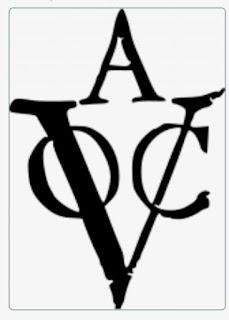Around the world and especially in English speaking countries, the VOC is widely known as the "Dutch East India Company". The name 'Dutch East India Company' is used to make a distinction with the British East India Company (EIC) and the other East Indian Companies (such as the Danish East India Company, French East India Company, Portuguese East India Company and the Swedish East India Company). the abbreviation "VOC" stands for 'Vereenigde Oost-Indische Compaigne' or 'Verenigde Oostindische Compagnie' in Dutch, literally meaning 'United East Indian Company' or United East Indies Company'.
The logo of the VOC was possibly the first globally recognized corporate logo and it appeared on various items such as cannon and coins.
The flag of the company was orange, white and blue, with the company logo embroidered on it.
In 1602, the Dutch government sponsored the creation of "United East Indies Company" that was granted monopoly over the Asian trade. The VOC traded throughout Asia.
Few in India realize that for almost 150 years during the early phase of European colonialism, when trading companies were trying to set themselves in the Indian Subcontinent, it was the Dutch who were the dominant players in the Trade.
Established by a charter in 1602, two years after its more famous "East India Company", it made such a grand success of it that it became the world's first multinational corporation in a modern sense.
It began trading on 11 November 1604 after a treaty was signed between the Zamorin of Calicut and the head of the Dutch fleet. The Zamorin wanted to use the Dutch to get the Portuguese out of the Malabar coast. The Dutch made two attempts but could not succeed. They however, established their presence on the east coast of India.
In 1608, they built their factory at Pulicat, 60 km north of Madras. Later they opened factories and trading centres all along the coast of present-day Andhra and Tamil Nadu, in places like Masulipatnam, Nagapattinam, Nizamapatnam, Sadurangapattinam, Bimilipatam and even as far as Golconda. They traded in textile, silk and diamonds. They later established trading centres throughout India, from Surat in 1616 to Bengal in 1627. In Bengal they had factories in Dhaka, Murshidabad and Chinsurah (near Calcutta).
By 1661, they captured the entire Malabar region from the Portuguese after capturing Kollam and Kochi the following year and were now controlling the Pepper trade too. By 1693, the Dutch captured Pondicherry from the French. The layout of Pondicherry was planned by the Dutch, though later they got it back in 1699.
VOC was the world's first limited liability company and the first to be listed on the newly formed Amsterdam Stock Exchange in the early 1600s where even the Belgian and German merchants bought their shares.
Just for interest, statistically the VOC eclipsed all of its rivals in international trade for almost 200 years of existence. Between 1602 and 1796 the VOC sent almost a million Europeans to work in the Asia trade on 4,785 ships. In comparison, the rest of Europe combined sent 8,82,412 workers and the fleet of the British East India Company utilized about 2,690 ships.
The Dutch operated a number of mints in India. These were in Cochin, Nagapatnam, Pulicat, Pondicherry and Masulipatnam.
Cochin Mint
Obverse: Kali with Sankha (shell) hanging from neck
Reverse: Kris (ceremonial knife) below OC (Oostindische Compagnie) above three rows of four dots
Obverse: 8 above VOC monogram inside a circle
Reverse; Conch in a circle
Nagapatnam Mint.
Obverse: Figure of goddess Kali standing facing
Reverse: Nagari legend "Rama Raya"
Obverse: VOC mark below retrograde N
Reverse: Legend in Tamil "Nakapattanam"
Obverse: Figure of Goddess Kali
Reverse; Inscription in Tamil "Nakapattanam"
Pulicat Mint
Obverse: Figure of Lord Venkateshwara standing facing front with lazy "J"
Reverse: Field of granulated dots
Obverse: PAL/III/VOC
Reverse: Arabic legend Sultan Abdallah
Pondicherry Mint.
Obverse: Figure of deity Kali
Reverse: Three lines Tamil legend Puddu/cher/i
By the mid 18th century onwards, the Dutch East India Company began a period of decline. In 1741, they faced a crushing defeat at the hands of Marthanda Varma, the ruler of Travancore in the Battle of Colachel (in Cape Comorin District). They had to cede their pepper trade to the Travancore kingdom. In the Fourth Anglo-Dutch War, 1780-1784 they suffered defeat at the hands of the British and by 1799 as the company suffered bankruptcy, its holdings were transferred to the Dutch Crown.
For the next two decades, the Dutch possessions in India were slowly shut down. In 1825, under the Anglo-Dutch Treaty, all the Dutch possessions in India were transferred to the British and it marked an end to the Dutch colonial rule in India.





















No comments:
Post a Comment
Any inputs or feedback is welcome!